A Study on the Cultural Identity of English Education Majors in a Common University
XIE Yanli LI Ye
Jilin University,Chang Chun,130000,China
[Keywords] cultural identity;Chinese traditional culture;culture teaching;English education major
1.Introduction
Identity is a complex concept in social science containing multiple dimensions.Generally defined as a tendency of individuals to identify with a certain group,it affects individual's relationships with others and the external environment respectively (Peng Yue,Chen Lihua,2021).Cultural identity which is an extension of the concept of identity was first proposed by Eriksson,an American psychologist,in 1953.Han Zhen (2006) holds that cultural identity emerges from people’s desire to seek stability due to the diversity of social existence.In this paper,cultural identity refers to the identification of social norms and practices as well as the psychological process through which people integrate their own national culture in the sociocultural context and create a sense of belonging.Chinese culture,which serves as both a mental bond that safeguards the unity of the nationalities and a spiritual force that promotes the prosperity of national culture,is exactly the psychological and social demands of Chinese people.
Learners who employ both target language and native language in authentic situations,no matter in the classroom or in real life,have membership in more than one cultural group and experience identity conflicts and coordination constantly(Qin Chen,2012).Foreign language learning may lead to changes in their communication styles and cultural identity,as the acceptance of a new language may indicate that of a new sociocultural or behavioral pattern (Feng Hui,An Shourong,Zhu Li Jiao,2015).Lambert,for example,proposes two main types of changes,subtractive bilingualism and additive bilingualism(Lambert,1973).Gao Yihong draws inspiration from E.Fromm's concept of productive orientation and proposes productive bilingualism (Gao Yihong,2001).Subsequently,researches on identity are extended to college students,and the relationship between foreign language learning and cultural identity is further confirmed(Gao Yihong,2004;Ren Yuxin,2008;Liu Qiong,Peng Yan,2006;Bian Yongwei,2011).
Whether this kind of relationship is positive,however,is still a contentious issue.Some academics believe that learning foreign languages weakens one’s cultural consciousness,leaving them confused about their identity which is adverse to constructing their national cultural identity(Pagliai,Ⅴ.2000;Chen Xinren,2018; Du Xiulian,2015; Han Haiyan,2014; Luo Di,2014; Liu Lu,Gao Yihong,2012; Qin Yizhu,Li Yingdi,2019;Zhu Yanjun,2019).Others,on the contrary,contend that foreign language learning can help one better keep their national cultural identity in that it is still generally kept within a reasonable and acceptable range,despite their existing certain changes caused by foreign languages (Cheng Weimin,Xiong Jianshen,2016; Jian Zhenyue,2020; Li Caina,2018; Liang Zhiling,2022; Wang Huamin,Xia Yihong,Luo Qin,2022).
This controversial situation creates complex dilemmas that may influence the reform of English education,demonstrating the need for additional research to ascertain the impacts of changes that foreign languages may have on learners’ cultural identity.It is worth noting that most researches mainly concentrate on non-English majors or focus on the comparison between them and English majors rather than English majors specifically when it comes to the choice of research subjects,in spite of the fact that the latter have more exposure to western culture and may make their living relevant to English,especially becoming English teachers who may further affect the values of later generations more or less.Some Chinese scholars are concerned that even English majors who have attained the proficiency of TEM-8 still have difficulty in spreading Chinese culture in English,a phenomenon known as "Chinese cultural aphasia" that may reflect their lack of cultural identity to some degree (Feng Hui,An Shourong,Zhu Li Jiao,2015;You Dan,2012).What’s more,it is also found that common colleges③Common colleges refer to colleges excluded from national “211 Project” and “985 Project” series of key universities.,as an important part of Chinese higher education institutions and the main carrier of educational popularization,take up a large part of universities in China,but tend to receive less attention in research compared to key universities.Therefore,it is critical to ascertain the cultural identity of English Education majors from common colleges and examine their capacity for bidirectional communication between cultures,so as to help them build up self-confidence and proper pride of national culture.
Attempting to address this gap,this study presents and analyzes the cultural attitudes and behaviour of English education majors in a common college and aims at gaining a complete understanding of both the learners’cognition of national culture,and their ability to spread it,thus exploring the impacts of foreign language learning on their cultural identity.To achieve these goals,we choose 34 English Education majors in Grade 4 who are about to enter the workplace to become the spreader of national culture in comparison to other grades at random from a common college,adopt the questionnaire with 4 dimensions of language culture and values,cultural behaviors,cultural knowledge and communication skill,as well as cultural learning environment respectively,use SPSS 26.0 to make further analysis in uncovering reasons for cultural phenomenon and finally provide pedagogical suggestions accordingly based on the Kramsch'sⅤiew of Multicultural Interaction.
The following research questions are put forward accordingly:
1.What is the current situation of English Education majors'cultural identity in different dimensions?
2.What is the capacity of English Education majors to learn and spread national culture?
It is of considerable theoretical and practical importance in the background of globalization to further understand the current situation of English education majors' cultural identity.On the one hand,this study offers feasible suggestions on solving existing problems in teaching,reminding teachers of students'language learning experience,so as to strengthen the positive role of foreign language teaching.On the other hand,it contributes to the spread of Chinese traditional culture among English Education majors,helping cultivate and improve their cognitive competence and affective competence in intercultural communication.
2.Kramsch's View of Multicultural Interaction
Claire Kramsch (1993) argues that culture has diversity,complexity,and uniqueness and it is so common for individuals in such a diverse society to hold different opinions that it is unadvisable to avoid conflict blindly,as conflict is a process involving interaction.Effective intercultural communication,in her opinion,is based on both the proficiency in native language and the acquisition of target language.
She advocates the model of multicultural interaction in this regard,that is achieving the transition from the input of western culture solely to two-way cultural interaction in foreign language teaching,helping students explore the potential meaning in specific contexts and achieve deeper understanding.This model reveals the essence of cultural teaching and attempts to realize its multifaceted nature through comparison and interaction between western culture and national culture,thus not only broadening the vision of cultural teaching,but also truly achieving equal communication,correcting the tendency of emphasizing teaching content while ignoring teaching process.
The Kramsch Ⅴiew of Multicultural Interaction based on cultural equality and variety contributes to cross-cultural collaboration and exchange in general and develops students' intercultural awareness and communication abilities specifically.It therefore serves as the theoretical basis of this paper.
3.Research Instrument
The questionnaire with four dimensions listed as below is adopted as the research method.There are a total of 16 questions carried out from the following 4 aspects:

Table 3-1 Item Distribution
The first two dimensions are designed to answer the first research question which is to grasp the whole outline of English education majors' cultural identity by understanding their cultural values,attitudes,and behaviors.The third dimension is to understand learners'ability to spread national culture so as to answer the second research question and the fourth dimension attempts to reinforce the positive effect of language teaching by getting to know learners’ cultural learning environment and providing pedagogical suggestions.
The reliability of the questionnaire is analyzed using SPSS26.0.
As can be seen from Table 3-2,Cronbach's Alpha value of the questionnaire is 0.834>0.8,which means that the questionnaire has high reliability and data are reliable.

Table 3-2 Cronbach reliability analysis
As can be seen from Table 3-3,the KMO value of questionnaire is 0.614,indicating that the sample size meets the requirements,and the data is suitable for factor analysis.

Table 3-3 KMO and Bartlett's test
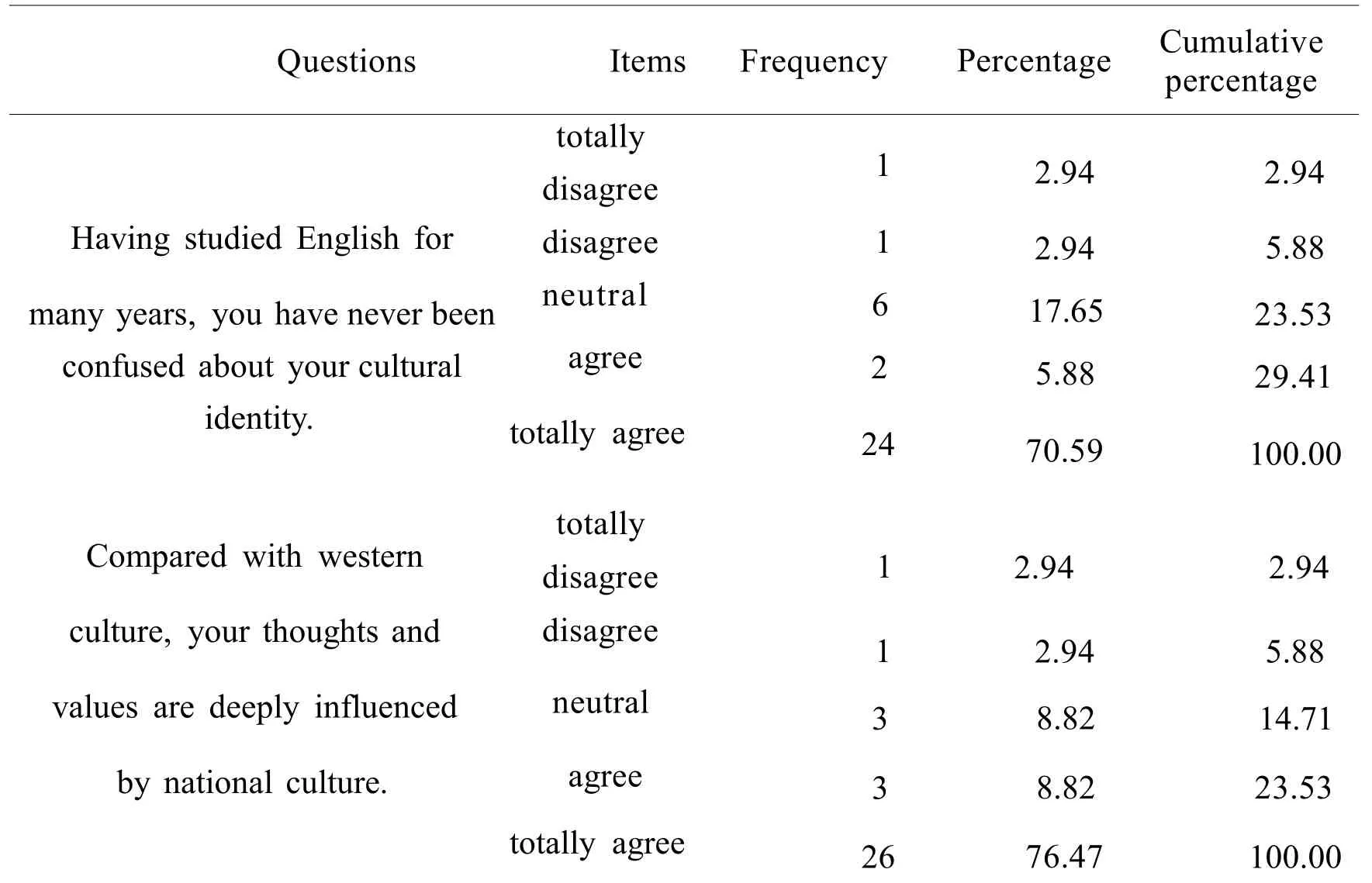
Table 4-1 Attitudes towards Native Culture on the whole
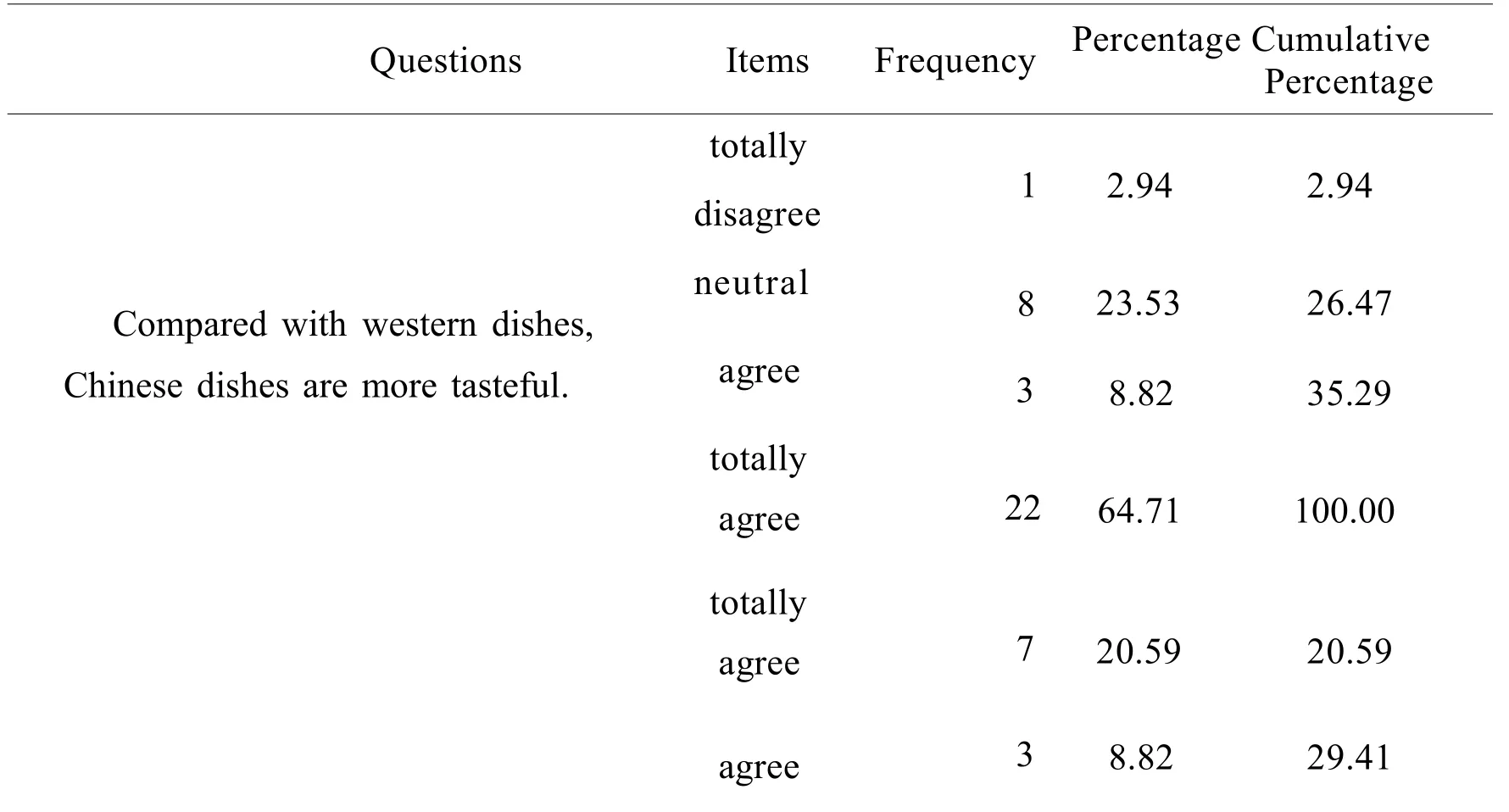
Table 4-2 Cultural Behavior of Diet

Table 4-3 Cultural Behavior of Communication
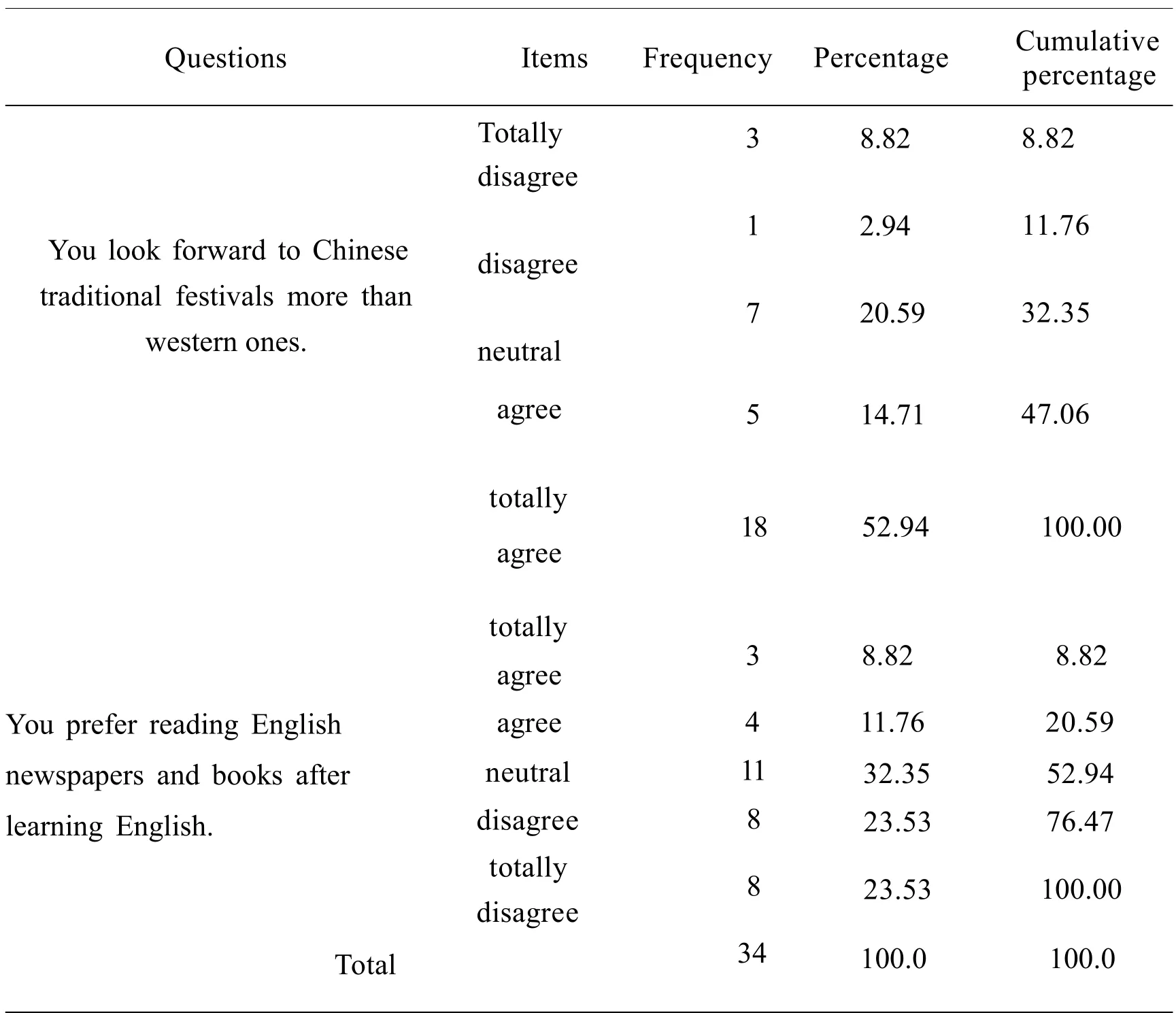
Table 4-4 Other Cultural Behavior
34 English majors were invited to complete the questionnaire online on a Saturday evening within 10 minutes,guidance provided when needed.Then data were collected and the probability of each option was analyzed.
4.Results and Discussion
4.1 Current Situation of Cultural Identity
The following results of English majors’cultural attitude are obtained,using the frequency analysis.70% of respondents have never been confused about their cultural identity in terms of language,culture,and values.And 76% of respondents assert that Chinese traditional culture has a significant influence on their thoughts and values relative to target culture,which suggests that their cultural identity is relatively clear on the whole,confirming the above conclusion.Besides,more than half of the students think it is necessary to introduce fine traditional culture to foreigners when communicating,indicating their awareness of cultural transmission.
Consequently,it can be concluded that English education majors with clear cultural identity hold confidence in Chinese culture and have a strong sense of affinity with it on the whole.However,the fact that still a tiny percentage of respondents lack their cultural identity must also be taken into consideration.
Then,the analysis of learners' cultural behavior,including diet,communication,festivals and so on is as follows:
While Chinese food is regarded to be more palatable to 64% of the students,29% of respondents preferring Dutch treatment,which may be the result of personal preferences,but the impacts of western culture can’t be ignored as well.
In terms of daily communication,nearly 30% of respondents do not advocate speaking English alternately in their speech,and the majority of them hold the view that it is improper to talk about the topics such as age and income which reflects the influence of western culture.
Chinese festivals are preferred by more than half of the respondents,indicating a relatively high level of cultural identity overall.In total,46% of respondents are more inclined to read English books and newspapers,which may be related to the requirement for English proficiency.
4.2 Cultural Knowledge and Communication Competence
Firstly,the analysis of learners’command of national culture is as follows.
As can be seen from Figure 4-1,41% of the respondents believe that they have a good command of traditional culture,but there is still 29% students thinking that their mastery of traditional culture is deemed to be general.
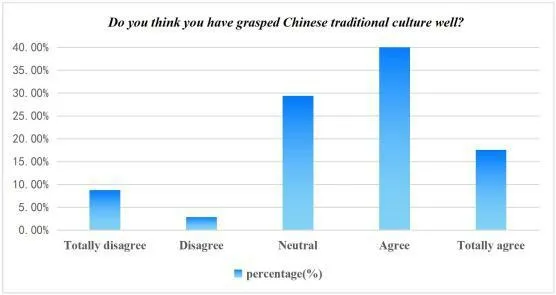
Figure 4-1
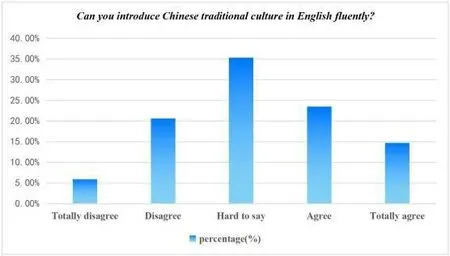
Figure 4-2
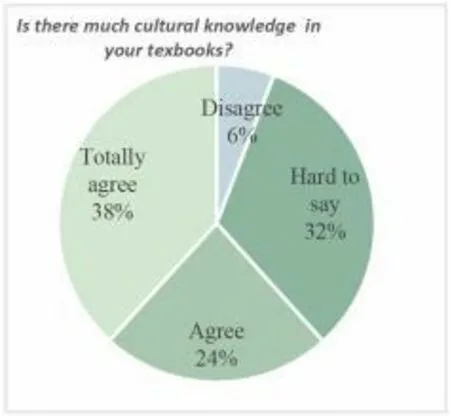
Figure 4-3 Cultural Knowledge in Textbooks
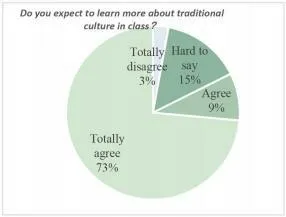
Figure 4-4 The Willingness to Learn Traditional Culture
As shown in Table 4-5,the goodness-of-fit test shows statistically significance (chi=9.566,p=0.0230.05),indicating that there are substantial differences in the selection ratios of each item that may be compared by either the response rate or the popularity rate.It can be found that students typically hold that their inability to understand classical Chinese and the genres’lack of connection to reality are major hindrance to their reading of ancient Chinese.
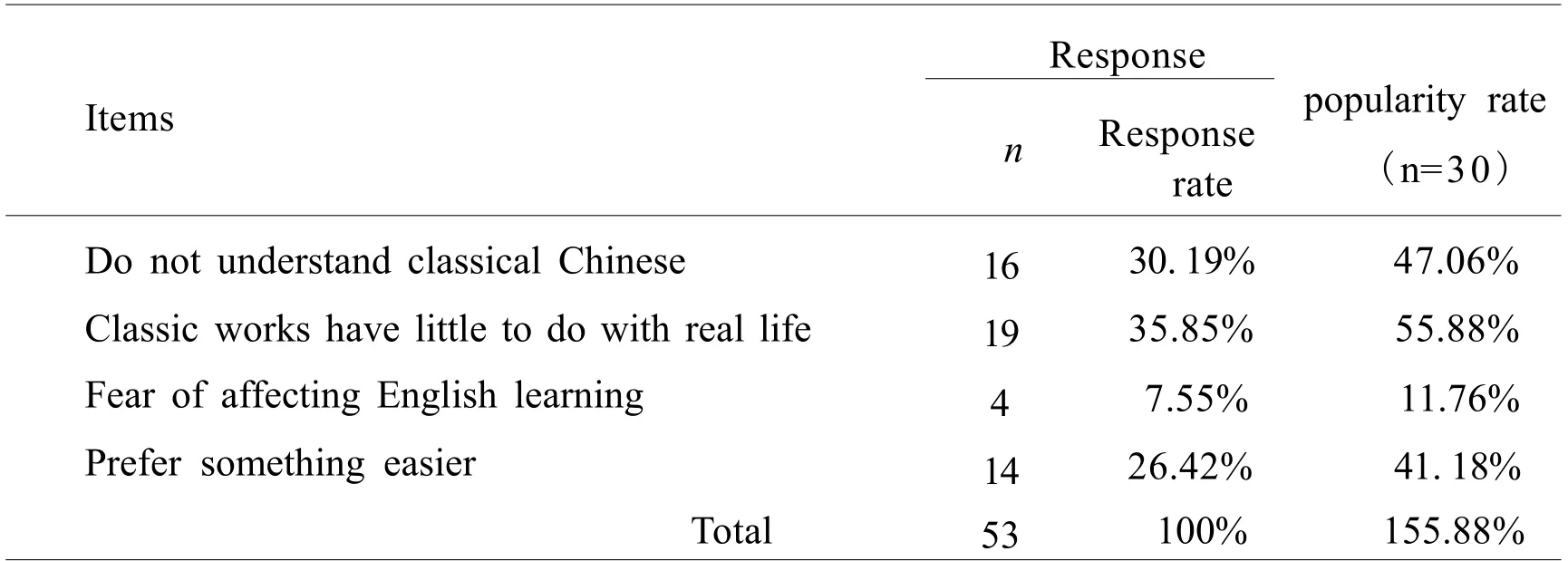
Table 4-5 The Reasons for Students’Insufficient Reading of Chinese Classic Work

Table 4-6 The biggest obstacle in spreading Chinese traditional culture
In addition,findings on the capacity of English education majors to spread their national culture are as follows.
The majority of respondents think it is hard to judge their abilities of spreading national culture in English,which indicates that the necessity of improving their intercultural communication competence.
Goodness of fit test: χ²=14.513 p=0.002
As can be seen from the above table,the goodness-of-fit test is statistically significant (chi=14.513,p=0.002<0.05),which shows the learners are suffering from the problem of poor oral English and inadequate vocabulary.
4.3 Cultural learning environment
As can be seen from Table 4-7,the goodness of fit test does not show statistically significance(chi=1.506,p=0.681>0.05)which implies that there exists no distinct difference between the selection ratio of each item,indicating the variety of techniques English education majors employed to acquire traditional cultural knowledge.
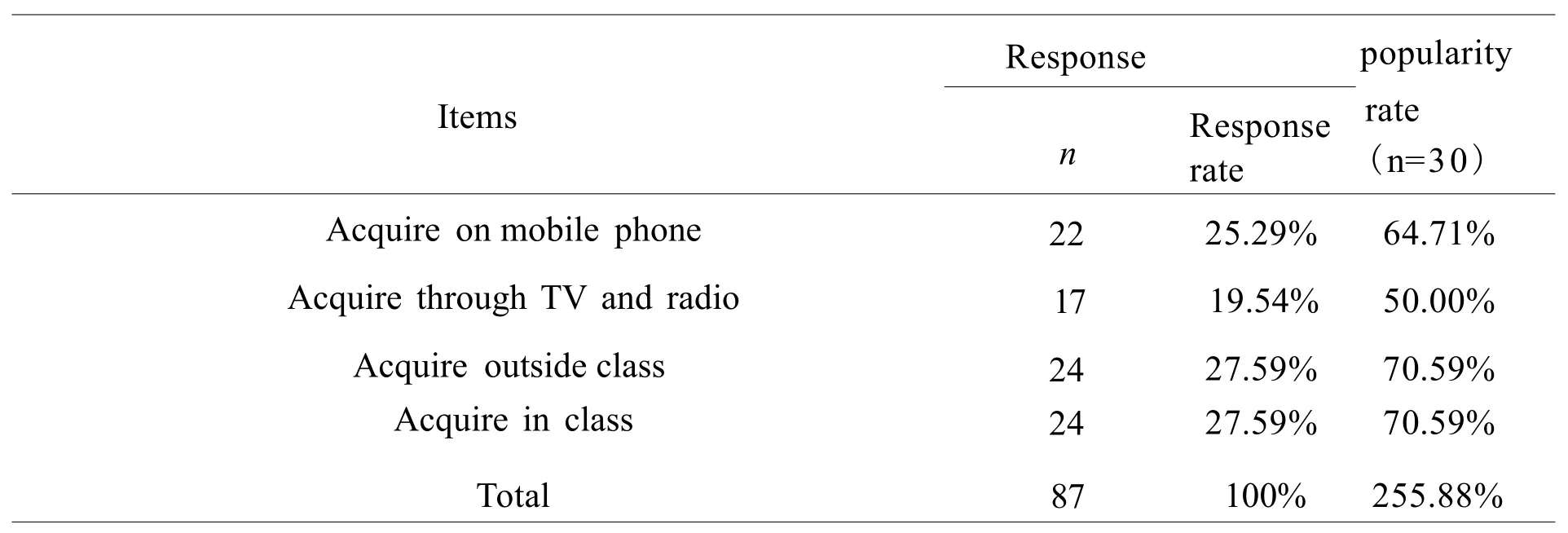
Table 4-7 Approach to Acquire Chinese Traditional Culture
While 32% of respondents have reservations,38% of them assert that their textbooks include a variety of cultural knowledge.It should also be noted that 73% of them desire to learn more about traditional culture in class,which provides favorable support for innovating teaching approaches.
5.Conclusion and Implications
5.1 Conclusion
Firstly,English education majors in common colleges generally exhibit a high affinity for their national culture according to the findings pertaining to cultural attitudes and behaviors.It is also important to note that many learners despite having correct values,are more vulnerable to the surface culture④Surface culture which is also called material culture embodies in basic necessities of life,such as food,clothing,shelter and transportation.as can be seen in some cultural practices,particularly in the field of diet and communication and most of them remain neutral in specific cultural attitudes and behaviors.
It can be concluded that the general effect of foreign language teaching is favorable while it may inevitably have some impacts on learners’perception of their national culture and unconsciously result in the formation of a new cultural identity.They still need guidance on treating western culture appropriately as a consequence,so as to help them seek common ground while reserving differences for their long-term cognitive development.
Secondly,while most English education majors claim to have a solid understanding of national culture,their failure to comprehend classical Chinese⑤Classical Chinese refers to the classical style of writing.(Wenyanwen)whose connection to contemporary life is thought among respondents to be weak may be the biggest obstacle to learning national culture.It shows the fact that certain expression may be hard for ones to accept if it is beyond the range of their cognition,indicating a lack of consideration on learners’recognition and emotional experience.What’s more,a sizable portion of learners who hold a negative view of their own cultural competency have concerns about their English communication skills when it comes to the transmission of national culture,showing cultural aphasia among English education majors.
Although there exist some negative signs in terms of learners’intercultural communication skills such as the lack of fluent spoken English and that of sufficient cultural knowledge,their culture learning in multiple ways with strong interest creates a favourable environment for further pedagogical reform.
5.2 Implications
National identity is the most persistent and far-reaching feeling of the citizens of a nation state,and has been externalized as national culture.The integration and transmission of national culture should not be ignored in foreign language teaching.Teachers should give equal weight to both the target language and the national language on the basis of multicultural interaction theory,so as to exert more positive effects on learners’cultural identity.The specific pedagogical suggestions are as follows.
Firstly,more Chinese elements should be added in foreign language teaching,especially in terms of material arranging and course setting.Specifically,this kind of input can cover aspects such as traditional philosophy,customs,literary and artistic architecture.Learners’ integrated skills of listening,speaking,reading and writing can be developed under the context of traditional Chinese culture so as to exert its large,yet unrecognized effects,giving learners an emotional experience.
In addition,given learners'multiple approach to learning,online platforms such as WeChat,Microblog,and campus websites can be used to propagate Chinese traditional culture in English,guiding learners to think about and discuss national culture so as to better construct their cultural identity by encouraging them to express their opinions actively instead of taking a neutral view.Meanwhile,teaching models can be furthered innovated by combining classroom teaching and online teaching.For example,it is advisable to fully use high-quality online resources such as Micro-Courses Online Ⅴideo and MOOCs⑥MOOC is short for Massive Open Online Course.to develop cultural education,or to build English network resource database related to national culture as an extension and supplement to classroom teaching.
Lastly,learners’ ability of spreading Chinese culture can be further developed on the one hand by appropriately increasing the English vocabulary of Chinese culture in teaching practice so as to construct learners’cultural identity and develop their English communication skill in an atmosphere of rich national culture.Cultural activities,on the other hand,such as cultural knowledge contests and voluntary activity of being an English tour guide,can be organized in order to improve learners’ ability and awareness of expressing traditional culture with English in the authentic language environment,thus making them qualified spreader of Chinese culture.
In a nutshell,the integration of Chinese culture in foreign language teaching enables students to understand the differences between the two cultures in terms of values,thinking modes and expressions in their connection and comparison,avoid the rote application of Chinese pragmatic models and treat western culture rationally,thus helping students to maintain appropriate cultural identity in cross culture communication,improve their communicative competence and become a qualified international talent.

